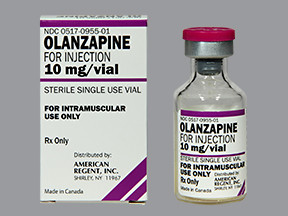OLANZAPINE - INTRAMUSCULAR
PHONETIC PRONUNCIATION: (oh-LAN-za-peen)
COMMON BRAND NAME(S): Zyprexa
GENERIC NAME(S): olanzapine
Uses
USES: This medication is used to treat severe agitation associated with certain mental/mood conditions (schizophrenia, bipolar mania). It works by helping to restore the balance of certain natural chemicals in the brain (neurotransmitters). Talk to the doctor about the risks and benefits of treatment (especially when used in teenagers). See also Precautions section.
How to use OLANZAPINE - INTRAMUSCULAR
HOW TO USE: Read the Medication Guide provided by your pharmacist before you start using olanzapine and each time you get a refill. If you have any questions, ask your doctor or pharmacist. This medication is given by a slow, intramuscular injection (IM) by a healthcare professional. The dosage is based on your medical condition and response to therapy. This medication is intended for short-term control of acute agitation symptoms. If you require continuous treatment for your condition, your doctor may switch you to an oral medication.
Side Effects
Precautions
Interactions
Overdose
Images
Reviews
Faq for OLANZAPINE - INTRAMUSCULAR
Olanzapine Intramuscular works by blocking certain neurotransmitters in the brain, including dopamine and serotonin, which helps to restore the balance of these chemicals and reduce symptoms of psychosis.
Olanzapine Intramuscular is used to treat symptoms of schizophrenia, such as hallucinations, delusions, disorganized thinking, and emotional instability. It can also be used to manage acute agitation in patients with bipolar disorder or major depressive disorder.
Olanzapine Intramuscular is typically administered as an injection into the muscle, usually the buttocks, thigh, or deltoid. It should only be given by a healthcare professional.
Olanzapine Intramuscular is designed for rapid onset of action, usually providing relief from symptoms within 30 minutes to 2 hours after administration.
Common side effects of Olanzapine Intramuscular may include drowsiness, dizziness, headache, weight gain, increased appetite, dry mouth, and constipation. It may also cause injection site reactions, such as pain or redness.
Olanzapine Intramuscular is not approved for use in children or adolescents under the age of 18. It may only be prescribed for adults.
The effects of Olanzapine Intramuscular can last up to 24 hours. However, it is important to follow the prescribed dosage and timing schedule as instructed by the healthcare provider.
While Olanzapine Intramuscular is primarily used for acute agitation or short-term treatment, it can also be prescribed for long-term maintenance treatment to prevent the recurrence of symptoms in patients with schizophrenia or bipolar disorder.
Since Olanzapine Intramuscular is usually administered by a healthcare provider, it is unlikely to be missed. However, if a dose is missed, it is important to contact the healthcare provider for further instructions.
Warning
WARNING: There may be a slightly increased risk of serious, possibly fatal side effects (such as stroke, heart failure, fast/irregular heartbeat, pneumonia) when this medication is used by older adults with dementia. This medication is not approved for the treatment of dementia-related behavior problems. Discuss the risks and benefits of this medication, as well as other effective and possibly safer treatments for dementia-related behavior problems, with the doctor.
Disclaimer
IMPORTANT: HOW TO USE THIS INFORMATION: This is a summary and does NOT have all possible information about this product. This information does not assure that this product is safe, effective, or appropriate for you. This information is not individual medical advice and does not substitute for the advice of your health care professional. Always ask your health care professional for complete information about this product and your specific health needs.




No Reviews Yet